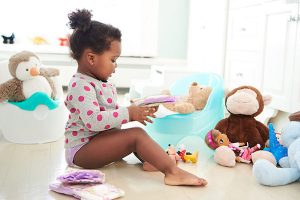 Pick a weekend to potty-train and check it off your list by Monday. Sounds amazing, right? In reality, it may take a bit more time (8 weeks or so) for your little one to be accident-free, but it is possible to teach her the gist of using the potty in 1-3 days.
Pick a weekend to potty-train and check it off your list by Monday. Sounds amazing, right? In reality, it may take a bit more time (8 weeks or so) for your little one to be accident-free, but it is possible to teach her the gist of using the potty in 1-3 days.
Highlights:
|
The idea of Fast-Track potty training (FT) was first introduced in the 1970s by psychologists Nathan H. Azrin and Richard M. Foxx. Today there are countless potty training methods based on their approach, including 3-Day Potty Training, Oh Crap Potty Training, and The Potty Boot Camp. Each method offers a unique twist, but here’s an overview of Azrin and Foxx’s steps:
- Do your homework. This is where the “fast-track” label is a tad misleading. While the actual training may be short-term, FT is regimented. It requires understanding the method, making a plan, and sticking to it. Reading the FT book of your choice before starting is key.
- If your child is 20 months old and shows signs of readiness, pick a day (or two or three, depending on which method you follow) and dedicate it to potty training. Clear your schedule and plan to stay home. It’s a good idea to have siblings stay with Grandma if possible, so you and your toddler are free of distractions; this approach is all-potty all-the-time.
- Dress your child in training pants (newer versions of the method call for underwear, or nothing at all).
- Use a potty seat and a doll (preferably one that “drinks” water and then “pees” it out) to act out the doll drinking, using the potty, and washing her hands. Praise the doll and offer her a reward (a treat or a sticker, for example). Stage a doll-peeing accident and “overcorrect” by having the doll sit on the potty right afterwards. Have your child participate in this play until she understands the routine (Azrin and Foxx say this takes about an hour).
- Give your child a lot to drink, and remind her to use the potty when she needs to pee or poop. If she does, praise her and offer her a reward. If she has an accident, overcorrect by having her practice using the potty immediately after.
Things to Keep in Mind
Unlike Child-Oriented Potty Training, FT calls for parents to exert more control. It’s still important, though, to back off if your child reacts so negatively that it’s causing power struggles. Child development experts tend to agree that while some children may need a little nudge to potty train, pushing them too hard can have behavioral consequences.
FT isn’t suited for every parent and child. It may be a good fit for parents who do well with organization and structure. Children who are easy-going may zip through FT, while headstrong ones may do better with a child-oriented method, or a custom plan that borrows ideas from different methods but takes a longer-term approach. For instance, some parents like the gradual aspect of a child-oriented approach, but add in structure by scheduling regular potty breaks throughout the day.
Pros and Cons
The main pro here is that FT generally works, condensing what could be a long journey to the toilet into a short (albeit pee-filled) timeframe.
Cons are that it requires parents to do a lot of reading and planning, and you have to stop your life for training days. Just like any area of parenting, FT has expert detractors, who believe it pushes children too hard.
No matter how you plan to ditch diapers, be sure to read our article about inevitable potty-training roadblocks and how to get through them.








